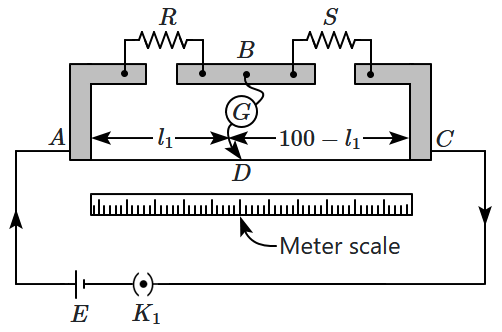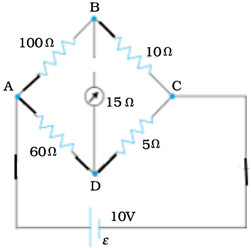What is the average drift speed of conduction electrons in a copper wire of cross-sectional area carrying a current of 1.5 A? Assume that each copper atom contributes roughly one conduction electron. The density of copper is and its atomic mass is 63.5 u.
An electric toaster uses nichrome for its heating element. When a negligibly small current passes through it, its resistance at room temperature (27.0 °C) is found to be 75.3 Ω. When the toaster is connected to a 230 V supply, the current settles, after a few seconds, to a steady value of 2.68 A. What is the steady temperature of the nichrome element? The temperature coefficient of resistance of nichrome averaged over the temperature range involved is 1.70 × 10–4 °C–1
The resistance of the platinum wire of a platinum resistance thermometer at the ice point is 5 Ω and at the steam point is 5.23 Ω. When the thermometer is inserted into a hot bath, the resistance of the platinum wire is 5.795 Ω. The temperature of the bath is:
A network of resistors is connected to a 16 V battery with an internal resistance of , as shown in the figure. The equivalent resistance of the network is:
A network of resistors is connected to a 16 V battery with an internal resistance of , as shown in the figure. The current in resistor between B and C will be:
A network of resistors is connected to a 16 V battery with an internal resistance of , as shown in the figure. The voltage drop across AB is:
1. 2 V
2. 25 V
3. 4 V
4. 6 V
A battery of 10 V and negligible internal resistance is connected across the diagonally opposite corners of a cubical network consisting of 12 resistors each of resistance (as shown in the figure). The total current in the network is:
The current in the branch AB in the given network is:
1. 5/8 A
2. 5/2 A
3. 15/8 A
4. 3/2 A
The four arms of a Wheatstone bridge have the following resistances as shown in the figure. A galvanometer of 15Ω resistance is connected across BD. What is the current through the galvanometer when a potential difference of 10 V is maintained across AC?
1. 4.87 mA
2. 3.72 mA
3. 5.01 mA
4. 2.65 mA
In a meter bridge (shown in the figure), the null point is found at a distance of \(33.7\text{ cm}\) from \(A.\) If now a resistance of \(12~\Omega\) is connected in parallel with \(S,\) the null point occurs at \(51.9\text{ cm}.\) The values of \(R\) and \(S\) are respectively:

1. \(13.5~\Omega,~6.86~\Omega\)
2. \(13.5~\Omega,~13.5~\Omega\)
3. \(6.86~\Omega,~6.86~\Omega\)
4. \(6.86~\Omega,~13.5~\Omega\)











